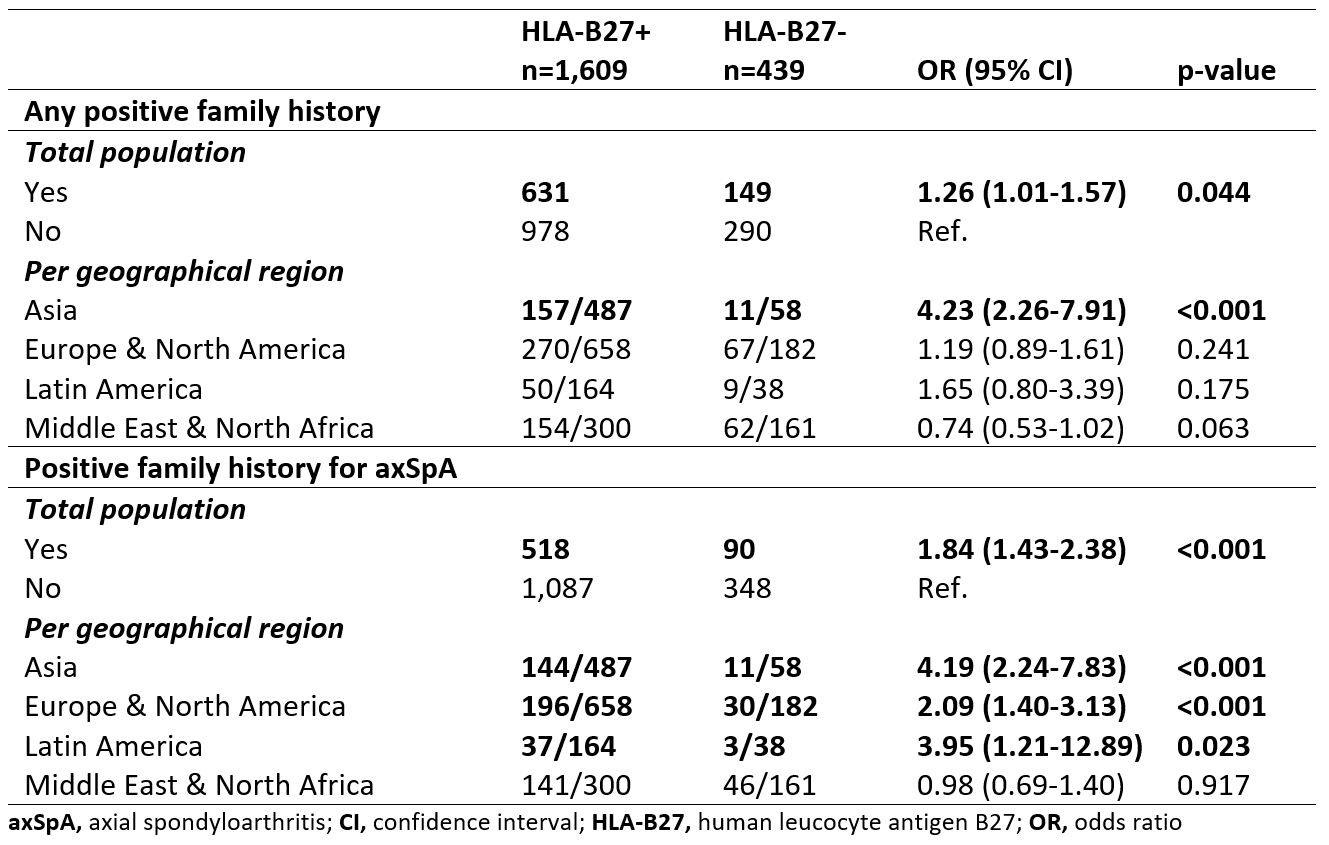Session Information
Session Type: Poster Session A
Session Time: 8:30AM-10:30AM
Background/Purpose: Research has shown that in patients with axial spondyloarthritis (axSpA), the most common form of spondyloarthritis (SpA) in a family history is axSpA. Moreover, the association between a positive family history of spondyloarthritis (PFH) and HLA-B27 carriership is driven by a PFH of axSpA and possibly acute anterior uveitis (AAU), but not by other forms of SpA. However, this research was limited to mostly Western European patients and it is unknown if this holds true in axSpA patients in other parts of the world. Therefore, we aimed to investigate the impact of geographical region on family history and its association with HLA-B27 carriership in patients with axSpA around the world.
Methods: Data from the Assessment in SpondyloArthritis international Society (ASAS) peripheral involvement in Spondyloarthritis (ASAS-perSpA) study was used. Analyses were restricted to patients with an axSpA diagnosis who had information available on HLA-B27 status and family history. The frequencies of any PFH, as well as a PFH for axSpA, psoriasis, AAU, inflammatory bowel disease (IBD) and reactive arthritis (ReA), were determined per geographical region. Logistic regression models were built to assess the effect of HLA-B27 status on the occurrence of any PFH and occurrence of each disease in a PFH in the total population and also stratified per geographical region.
Results: In total, 2,048 patients were included from 4 regions: Asia (n=545), Europe & North America (n=840), Latin America (n=202), and Middle East & North Africa (n=461). Patients had a median age (IQR) of 40 (31-50) years, 31% were female, and had a disease duration of 11 (5-20) years.
A PFH of axSpA was the most common in all geographical regions, regardless of HLA-B27 carriership. A PFH of psoriasis and IBD appeared to be more common in HLA-B27 negative patients, and a PFH of ReA was rare in all patients (Figure).
Univariable logistic regression models showed an association between a PFH and HLA-B27 carriership in the Asian population, but this association does not seem apparent in the other geographical regions (Table). Contrary, a PFH of axSpA was associated with HLA-B27 carriership in all geographical regions except the Middle East & North Africa (Table). An association between HLA-B27 carriership and a PFH of psoriasis was solely present in Middle East & North Africa (OR=0.4, 95% CI 0.2-0.7), and an association with a PFH of IBD was solely present in Europe & North America (OR=0.5, 95% CI 0.3-0.9). No associations were found for HLA-B27 carriership and a PFH of AAU and ReA in any geographical region.
Conclusion: Throughout the world, axSpA was the most common form of SpA in a family history. In all regions except one, a PFH of axSpA was associated with HLA-B27 carriership in axSpA patients. These results suggest that the current expert definition of a PFH of SpA should be revaluated.
To cite this abstract in AMA style:
van Lunteren M, Boel A, López Medina C, Sieper J, van der Heijde D, van Gaalen F. Geographical Prevalence of Family History in Patients with Axial SpA and Its Association with HLA-B27: Data from the Worldwide ASAS-perSpA Study [abstract]. Arthritis Rheumatol. 2021; 73 (suppl 9). https://acrabstracts.org/abstract/geographical-prevalence-of-family-history-in-patients-with-axial-spa-and-its-association-with-hla-b27-data-from-the-worldwide-asas-perspa-study/. Accessed .« Back to ACR Convergence 2021
ACR Meeting Abstracts - https://acrabstracts.org/abstract/geographical-prevalence-of-family-history-in-patients-with-axial-spa-and-its-association-with-hla-b27-data-from-the-worldwide-asas-perspa-study/


